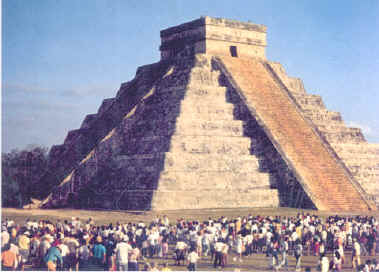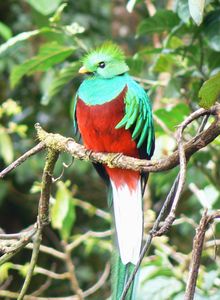 The singing stairs of the pyramid have lost some fidelity over the centuries, as the once smooth plaster finish erodes from each step, but one can still hear the famous echoes reflected back from hand claps, like the chirps of the Resplendent Quetzal, a bird who, according to Mayan legend, represents the plumed serpent Quetzlcoatl. The chirpy staircase of El Castillo is just one of many feats of “frozen music” (what Goethe called architecture) at the Mexican site of Chichen Itza, that honor the bird and her snake-bird god. During the Equinoxes, there is an undulating shadow display at the pyramid, like the scioform of the feathered deity himself, crawling up and down the limestone steps, the same spot from where his echoic voice chirps to the applause of pilgrims. Here is a sample of two quetzal chirps, followed by two echoes of hand claps off the pyramid. Their sonograms are identical. Our modern method of polycarbonate sound reproduction seems primitive when compared to the Mayan stoner rock recordings of the ancients, that have been coded into the architecture with clap-on tech.
The singing stairs of the pyramid have lost some fidelity over the centuries, as the once smooth plaster finish erodes from each step, but one can still hear the famous echoes reflected back from hand claps, like the chirps of the Resplendent Quetzal, a bird who, according to Mayan legend, represents the plumed serpent Quetzlcoatl. The chirpy staircase of El Castillo is just one of many feats of “frozen music” (what Goethe called architecture) at the Mexican site of Chichen Itza, that honor the bird and her snake-bird god. During the Equinoxes, there is an undulating shadow display at the pyramid, like the scioform of the feathered deity himself, crawling up and down the limestone steps, the same spot from where his echoic voice chirps to the applause of pilgrims. Here is a sample of two quetzal chirps, followed by two echoes of hand claps off the pyramid. Their sonograms are identical. Our modern method of polycarbonate sound reproduction seems primitive when compared to the Mayan stoner rock recordings of the ancients, that have been coded into the architecture with clap-on tech.
In the cloud forest, where the fog cover trumps vision, you are more likely to hear a Quetzal than see one. Their song is a plaintive kyow that is often compared to the whimper of a puppy. The kyows are performed in call and answer form by males and females (Remember this is the Neotropics where the girls sing too). They seem to follow a simple pattern, where alternating kyows fall in smaller intervals. The first call goes down a Perfect Fifth, and the smaller second call only goes down a Fourth. There are also high E Tones, like appoggiaturas, that precede each kyow.

 In the ancient world, the biggest noise polluters were the birds, insects, and weather. Humanity paid much greater attention to the sounds around her. Echoes were believed to be the voices of spirits by many ancient cultures, and the Resplendent Quetzal and her invisible song is still regarded as “the spirit of Maya”.
In the ancient world, the biggest noise polluters were the birds, insects, and weather. Humanity paid much greater attention to the sounds around her. Echoes were believed to be the voices of spirits by many ancient cultures, and the Resplendent Quetzal and her invisible song is still regarded as “the spirit of Maya”.
Quetzals were venerated by the Pre-Columbian Mayans and Aztecs for their iridescent green plumage (and magical flying abilities). It was common for Mesoamerican nobility to sport quetzal feathers in their headdress, but because of the bird’s sacred status, it was a crime to kill them, and feathers were simply extracted (albeit inhumanely) before releasing the skylord back into the cloud forest. Today, quetzals are threatened to near extinction. They are known to kill themselves in captivity, rather than breed for our zoos.
According to legend, Quetzals used to sing beautiful songs, rivaling the Neo-tropic wren in musicality, but have remained silent ever since the Spanish Conquest, save for their whimpering kyows.
Kyowwwwwwwwwwwww….
Notes:
Lubman, David, ‘An archaeological study of chirped echo from the Mayan pyramid of Kukulkan at Chichen Itza’, http://www.ocasa.org/MayanPyramid.htm, http://www.ocasa.org/MayanPyramid2.htm.




Love the broad range of coverage in this post and how you tied it all together. There is now a soft spot in my heart for the quiet quetzal!